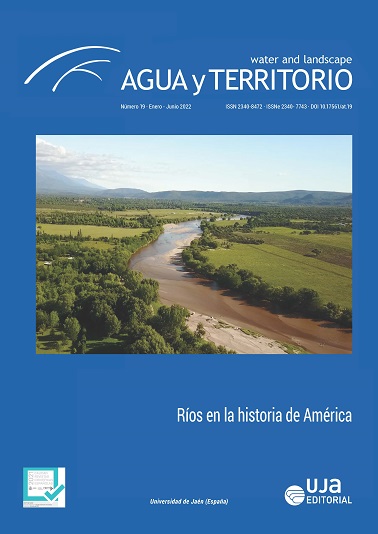O Río Grande e o corredor interoceânico da região de trânsito do Panamá, 1500-1914
DOI:
https://doi.org/10.17561/at.19.5461Palavras-chave:
Rios, Canal do Panamá, História ambiental, Río Chagres, TransitismoResumo
A história do Rio Grande, um rio panamenho que deságua no Pacífico e cujo vale foi devastado com a construção do Canal do Panamá, oferece um caso pré-agitado de um rio latino-americano sujeito a extrativismo e de uma bacia crucial na história ambiental da região de trânsito do Panamá. O caminho do rio será reconstruído a partir de uma narrativa apoiada na perspectiva explicativo-realista da história ambiental, especialmente os conceitos de metabolismo social como estímulo e a lacuna metabólica como fator explicativo das paisagens que produzem a atual crise. Devido ao estreito território da atual República do Panamá e à organização de sua principal atividade econômica, a transformação do Rio Grande foi determinada pela ecologia política nacional, em várias escalas e ao longo de um longo período delimitado pela validade do transitismo como paradigma elites atuais de tomada de decisão.
Downloads
Referências
Acervo del Canal de Panamá (Record Group 185). Archivos Nacionales de Estados Unidos NARA II (Siglas en Inglés). College Park, Maryland, EEUU.
Aboites Aguilar, L. 1999: El agua de la nación. Una historia política de México (1888-1946). Ciudad de México, CIESAS.
Alfaro-Rodríguez, E. 2017: “La red social del abasto urbano: aguadores y fiadores en Zacatecas, México (siglo XIX)”. Agua y Territorio, 9, 11-21. https://doi.org/10.17561/at.v0i9.3473
Arosemena, M. 1999: Apuntamientos Históricos (1801-1840). Panamá. Autoridad del Canal de Panamá.
Bunker, S. G. 2007: “Natural Values and the Physical Inevitability of Uneven Development under Capitalism”, en Hornborg, A.; McNeill, J. R. & Martinez-Alier, J. (coords.): Rethinking Environmental History: World-System History and Global Environmental Change, Altamira Press, 239-258.
Camaño J., Luis A., y Daniel Quintero. 2017: “Enfoque Histórico-Geográfico Del Río Grande y Su Legado al Canal de Panamá.” Societas, 19 (1), 73-91.
Carse, A. 2014: Beyond the Big Ditch: Politics, Ecology, and Infrastructure at the Panama Canal. Cambridge, Massachusetts. MIT Press. https://doi.org/10.7551/mitpress/9780262028110.001.0001
Carse, A.; Keiner, C.; Henson, P. M.; Lasso, M.; Sutter, P. S.; Raby, M. & Scott, B. 2016: “Panamá Canal Forum: From the Conquest of Nature to the Construction of New Ecologies”. Environmental History, 21 (2), 206-287. https://doi.org/10.1093/envhis/emv165
Castillero Calvo, A. (Ed.) 2013: Panamá: Historia Contemporánea. Taurus.
Castillero Calvo, A. 1974: “Transitismo y Dependencia: El Caso de Panama”. Anuario de Estudios Centroamericanos, 1, 165-186. https://www.jstor.org/stable/25661524
Castro Herrera, G. 2008: “Isthmus in the World: Elements for an Environmental History of Panama”. Global Environment, 1, 10-55. https://doi.org/10.3197/ge.2008.010102
Castro Herrera, G. 2013: “Panamá, Un territorio en tres tiempos”. Historia Ambiental Latinoaméricana y Caribeña, 3 (1), 144-154. https://www.halacsolcha.org/index.php/halac/article/view/172
Frenkel, S. 1996: “Jungle Stories: North American Representations of Tropical Panama”. Geographical Review, 86 (3), 317-333. https://doi.org/10.2307/215497
Heckadon Moreno, S. 1993: “Impact of Development on the Panama Canal Environment”. Journal of Interamerican Studies and World Affairs, 35 (3), 129-149. https://doi.org/10.2307/165971
Hodges, H. F. 1916: “General Design of the Locks, Dams and Regulating Works of the Panama Canal,” en The Panama Canal II: Design and Erection of Structures, Transactions of the International Engineering Congress. San Francisco, California. Press of the Neal Publishing Company.
Jaén Suárez, O. 1998: La Población del Istmo de Panamá: Estudio de Geohistoria. Madrid. Ediciones de Cultura Hispánica.
Jaén Suárez, O. 1986: Geografía de Panamá: estudio introductorio y antología. Panamá. Universidad de Panamá.
Lasso, M. 2015: “A Canal without a Zone: Conflicting Representations of the Panama Canal”. Journal of Latin American Geography, 14 (3), 157-174. https://doi.org/10.1353/lag.2015.0035
Lasso, M. 2019: Erased: The Untold Story of the Panama Canal. Cambridge, Massachusetts, Harvard University Press. https://doi.org/10.2307/j.ctvckq61b
Mahan, Alfred Thayer.1890: The Influence of Sea Power Upon History, 1660-1783. Boston, Massachusetts. Little, Brown and Company.
Martos-Núñez, E. y Martos-García, A. 2015: “Memorias e imaginarios del agua: nuevas corrientes y perspectivas”. Agua y Territorio, 5, 121-131. https://doi.org/10.17561/at.v0i5.2539
McGuinness, Aims. 2008: Path of Empire: Panama and the California Gold Rush. Ithaca, Nueva York. Cornell University Press.
Peet, R. 1985: “The Social Origins of Environmental Determinism”. Annals of the Association of American Geographers, 75 (3), 309-333. https://doi.org/10.1111/j.1467-8306.1985.tb00069.x
Ring, N. J. 2012: The Problem South: Region, Empire, and the New Liberal State, 1880-1930. Athens, Georgia, University of Georgia Press.
Sutter, P. 2007: “Nature’s Agents or Agents of Empire? Entomological Workers and Environmental Change During the Construction of the Panama Canal”. ISIS, 98 (4), 724-754. https://doi.org/10.1086/529265
Publicado
Edição
Seção
Licença
Copyright (c) 2021 Francisco Javier Bonilla

Este trabalho está licenciado sob uma licença Creative Commons Attribution 4.0 International License.
© Universidad de Jaén-Seminario Permanente Agua, territorio y medio ambiente-CSIC.
Os originais publicados nas edições impressa e eletrônica desta Revista são propriedade da Universidade de Jaén e do Seminário Permanente Água, Território e Meio Ambiente (CSIC), assim como das Universidades que publicam monografias específicas na América Latina ou Europa. A origem deve ser citada em qualquer reprodução parcial ou total.
Salvo indicação em contrário, todo o conteúdo da edição eletrônica é distribuído sob uma licença "Creative Commons Attribution Spain" (CC-by). Você pode consultar daqui a versão informativa e o texto legal da licença. Esta circunstância deve ser expressamente declarada desta forma quando necessário.














